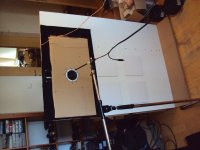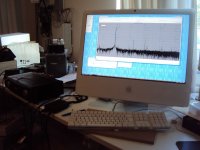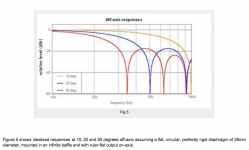Yes, but not grotesque like some others.
Today i measured the tweeter. That took longer then anticipated so i will measure the woofer tomorrow. i got a rather detailed analysis though.
Here some pictures from the setup.
Today i measured the tweeter. That took longer then anticipated so i will measure the woofer tomorrow. i got a rather detailed analysis though.
Here some pictures from the setup.
Attachments
Here are the frequency response measurements on the Satori tweeter on the 1.2m x 1.2m baffle. The bumps in the response under 3kHz are an artifact of the baffle.
It disappears in the near field response.
The on- and off-axis response was measured in 50cm and the near field response in 10cm.
The measurements where taken at 0°, 10°, 20°, 30° and 45°.
It disappears in the near field response.
The on- and off-axis response was measured in 50cm and the near field response in 10cm.
The measurements where taken at 0°, 10°, 20°, 30° and 45°.
Attachments
Here are the near field measurements at 0°, 15° and 45°.
The second measurement is in the near field at 45° and 60°. The characteristic notch is highest on 45° and shifts down in frequency and depth at 60°. That is a geometric artifact because parts of the membrane reach the microphone early and some later from the far side.
The second measurement is in the near field at 45° and 60°. The characteristic notch is highest on 45° and shifts down in frequency and depth at 60°. That is a geometric artifact because parts of the membrane reach the microphone early and some later from the far side.
Attachments
Here is harmonic distortion, second and third, at medium volume and high volume.
The high volume was rather challenging loud on my ears.
Measurements like this are hard to interpret because a comparison can only being made when a competing tweeter is measured at the same volume and distance.
This measurement was also taken in the near field.
The high volume was rather challenging loud on my ears.
Measurements like this are hard to interpret because a comparison can only being made when a competing tweeter is measured at the same volume and distance.
This measurement was also taken in the near field.
Attachments
Here is a multi tone test. 31 frequencies spread in such a way that they do not inter modulate much with themselves. This test is also know as Spectral Contamination.
The first test is with the driving signal and the other shows the multitones notched out so that is a so called Belcher Test.
The first test is with the driving signal and the other shows the multitones notched out so that is a so called Belcher Test.
Attachments
Here is a test you may have not seen before. Without a better word for it i called it Gerhard Test. This is the distortion residuum with the multi tones notched out and transferred into the time domain by doing a back FFT.
You see that the residuum is at about plus-minus 2uPascal, a low value.
I have also recorded a WAV file where you can listen to this residuum.
I am not able to upload that here so if anybody has an idea how i can share it you are welcome.
You see that the residuum is at about plus-minus 2uPascal, a low value.
I have also recorded a WAV file where you can listen to this residuum.
I am not able to upload that here so if anybody has an idea how i can share it you are welcome.
Attachments
From the multi tone and harmonic distortion measurements i concluded that the tweeter
should not be crossed over deeper then 1.8kHz with aprox. 12dB/oct.
The notch at 45° is prove that this tweeter does not break up in the audible range like normal soft domes do. The membrane is fixed in the middle so breakup is shifted up around one octave. The tweeter now behaves more or less like a rigid plane in the audible range so the notch happens because of geometric reasons. I have seen simulations from Technics and Phillips in the old days when they made honeycomb tweeters with a flat membrane that had exactly this behavior so it is not a design flaw "per se " but a consequence of the physics. A normal 29mm soft dome has from ca. 8kHz a break up so that the outer voice coil moves outward with a positive signal and the middle of the membrane moves inwards. That makes the off axis response somewhat smoother but also creates distortion. Also the ring membrane of the Satori Tweeter is more extended in the super treble because it does not suffer on axis so much from the anti phase movement of the inner part of the membrane.
should not be crossed over deeper then 1.8kHz with aprox. 12dB/oct.
The notch at 45° is prove that this tweeter does not break up in the audible range like normal soft domes do. The membrane is fixed in the middle so breakup is shifted up around one octave. The tweeter now behaves more or less like a rigid plane in the audible range so the notch happens because of geometric reasons. I have seen simulations from Technics and Phillips in the old days when they made honeycomb tweeters with a flat membrane that had exactly this behavior so it is not a design flaw "per se " but a consequence of the physics. A normal 29mm soft dome has from ca. 8kHz a break up so that the outer voice coil moves outward with a positive signal and the middle of the membrane moves inwards. That makes the off axis response somewhat smoother but also creates distortion. Also the ring membrane of the Satori Tweeter is more extended in the super treble because it does not suffer on axis so much from the anti phase movement of the inner part of the membrane.
The on axis response of the Satori rises a bit in the range over 10kHz.
This is a slight diffuse field equalization that compensates partly the dropping response over 10kHz off axis. This will not sound shy in overtones but i find the power response that results from this very well judged. There is a slight energy drop centered around 7kHz so this tweeter will sound fast and extended but not sharp. That little dip can be equalized out by the crossover of cause. The tweeter is loud enough to pad it down a bit so the sound can ultimatively only being judges when the complete speaker is build and the crossover fine tuned by measurement and ear. I think that i will optimize the response of the monitor for 10° off axis where the tweeter is most flat.
In total i am very happy with this measurement concourse. This is a smooth, extended and low distortion tweeter with good sensitivity around 92-93dB.
This is a slight diffuse field equalization that compensates partly the dropping response over 10kHz off axis. This will not sound shy in overtones but i find the power response that results from this very well judged. There is a slight energy drop centered around 7kHz so this tweeter will sound fast and extended but not sharp. That little dip can be equalized out by the crossover of cause. The tweeter is loud enough to pad it down a bit so the sound can ultimatively only being judges when the complete speaker is build and the crossover fine tuned by measurement and ear. I think that i will optimize the response of the monitor for 10° off axis where the tweeter is most flat.
In total i am very happy with this measurement concourse. This is a smooth, extended and low distortion tweeter with good sensitivity around 92-93dB.
the tweeter membrane behaves like a surround, it rolls, and the suckout is due to the summation of the changing amplitude over the membrane. It's not like a piston, but clearly better as there's no antiphase. how does the curve look without the smoothing you have applied.??
Last edited:
Here is a new paper :http://www.extra.research.philips.com/hera/people/aarts/RMA_papers/aar11pu5.pdf
Here is another study :http://www.ase.uc.edu/~pnagy/ClassNotes/AEEM729 Ultrasonic NDE/Part 6.pdf
Here is a picture of a 25mm round, rigid piston. Unfortunately it is not measured at 45° where the notch will be shifted down in frequency even more. The notch in the Satori is somewhat deeper in frequency so it is not perfect rigid. I could not find a simulation of a ring radiator so far.
Attachments
- Home
- Vendor's Bazaar
- SB Acoustics Satori Monitor


